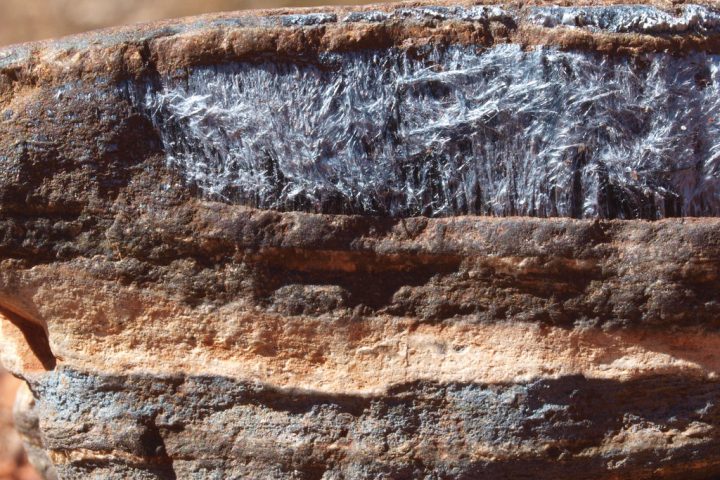Asbestos: The Silent Killer
By David Ren 任大偉

Once a miracle material, now a deadly killer. Asbestos, a white fibrous crystal, used to be found in just about everything: concrete, drywall, ceiling tiles etc. In fact it still is; over 50% of UK houses contained asbestos in 2011 despite it being banned in 1999 [1]. For residents in these homes, asbestos is a constant concern. A pipe leak or a wall renovation could release asbestos into the air and inhaled. At least 20 million people in the US have been unwittingly exposed to asbestos, which could potentially develop into mesothelioma, a type of lung cancer.
Its beginnings were innocuous enough. Asbestos is a good thermal insulator, electrical insulator, and is sound-absorbent. It was a popular material throughout history with a wide range of uses; Charlemagne wanted to make tablecloths from asbestos because past tablecloths had the tendency to accidentally catch fire during feasts [2]. In the 1800s, large-scale mining efforts brought the miracle material to every doorstep. It was used in over 3000 products: as insulation for electrical wiring; as cement; as fire-retardant coating; as roofing and flooring tiles; as thermal insulation for homes and offices; as brakes for automobiles. For this reason, asbestos was labelled ‘the mineral of the 20th Century.’ [3]
Yet, suspicion that asbestos was harmful to health was observed early on Murray observed an unusually high mortality rate in asbestos towns. For instance, a 33 year-old woman died after working in asbestos factories for 20 years in 1924. The postmortem autopsy of her lungs revealed significant fibrosis caused by ‘particles of mineral matter’ – asbestos [4]. This was the first diagnosis of asbestosis in the world and prompted a Parliamentary inquiry that led to the formal recognition of asbestosis as a disease. This disease is caused by an accumulation of microscopic asbestos fibres over time, irritating the lungs and eventually inflicting blood vessel damage. Asbestosis is also generally joined with mesothelioma, a cancer of the lung lining. The World Health Organisation (WHO) estimates that asbestos kills 107,000 people annually. The true figure is likely to be much higher, claims Professor Ken Takahashi [5].
Deciding what to do about asbestos is more complicated than it seems. Given the same evidence, policymakers come to diametrically opposing conclusions. It is certain that industrial-level exposure to asbestos generally causes long-term health problems. For example, mesothelioma occurs 7 times more likely than the national rate in Hampton Roads, a shipbuilding hub in World War II that heavily used asbestos [6]. Fear of this disease has prompted the Environmental Protection Agency (EPA) in the US to inspect schools for traces of asbestos. It will cost an estimated US$ 100-150 billion to eradicate the mineral from schools’ insulation, pipes, and ceilings. The good news is that asbestos does not seem to present a risk in low-exposure settings such as schools [7].
An average school or office has a substantially lower airborne asbestos concentration than unregulated workplaces of the past. The most dangerous type of asbestos is the long, thin fibre variant known as the amphipole. These are extremely rarely found inside buildings. An ordinary person is 300 times likelier to die from an automobile accident than from asbestos inhalation. If anything, the removal and subsequent storage of asbestos products will expose a higher number of workers to asbestos unnecessarily.
The debate rages between the parsimonious and the cautious regarding the removal of asbestos in the US. What is certain is that asbestos industries have migrated to developing countries. Losing their market in the West, asbestos firms have marketed the miracle mineral to Asia. Its use is rising by 7% each year in China, India, and Japan, which are among the top ten consumers of asbestos globally [8]. Their associated diseases are systematically underdiagnosed, making for misleading health statistics. Time will tell.
References
[1] Don, A. Asbestos: The Hidden Health Hazard in Millions of Homes. The Guardian (2011).
[2] Inglis-Arkell, E. The Sordid, Bizarre History of Asbestos Goes All the Way Back to Emperor Charlemagne. Retrieved from http://io9.gizmodo.com/5833469/the-sordid-bizarre-history-of-asbestos-goes
[3] Roselli, M. The Asbestos Lies: The Past and Present of an Industrial Catastrophe. European Trade Union Institute (2014). Retrieved from https://www.etui.org/content/download/14415/117522/file/FINAL_The_Asbestos_Lie.pdf
[4] Cooke, W. Fibrosis of the Lungs Due to the Inhalation of Asbestos Dust. The British Medical Journal, 147 (1924).
[5] Le, G. V., Takahashi, K., Eun-Lee, P., Delgermaa, V., Oak, C., Qureshi, A. M., Aljunid, S. M. Asbestos Use and Asbestos-Related Diseases in Asia: Past, Present and Future. Respirology (2011). DOI: doi:10.1111/j.1440-1843.2011.01975.x
[6] Burke, B. Horrible Toll Could Have Been Avoided. The Virgnian-Pilot (2001).
[7] Mossman, B., Bignon, J., Corn, M., Seaton, A., Gee, J. Asbestos: Scientific Developments and Implications for Public Policy. Science (1990), 247(4940), 294-301.
[8] Pandita, S. Banning Asbestos in Asia: Campaigns and Strategies by the Asian Network for the Rights of Occupational Accidental Victims. International Journal of Occupational Environmental Health (2006).